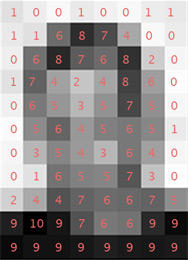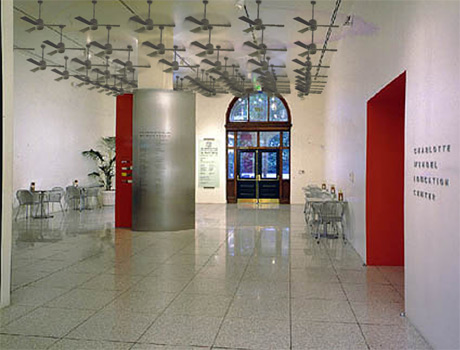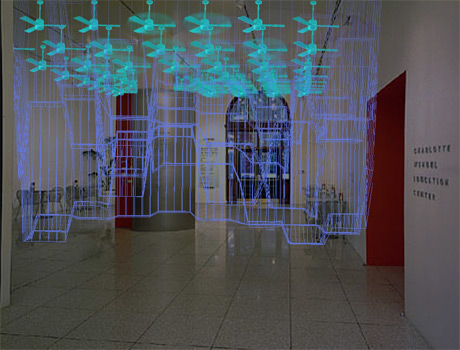

The online portion of the installation will consist of a Web site designed to elicit a simple question from users about the status of a current public issue of concern. Once this is submitted, the search engine retrieves key words from a Google NEWS search associated with the public issue “mood.” The user then chooses a cultural color model, which aligns the chosen color with the public issue “mood.” This color is then translated to a server in the destination installation space, which translates the designated color to a DMX controlled system of LED lights projected on the exhibition space ceiling. The entire colorcast of the installation space is then changed to this color. Online participants will be able to see the calculation process and its results in the room via webcam. When online users are not engaged in mood selections, the system will automatically search the web for public issue “moods” to continuously change the colorcast.
3 Net-Gift Mood Systems
Proposal for ISEA2006 C4F3
Will Pappenheimer
Intro:
This project proposes 3 Internet controlled atmospheric mood systems for
the ISEA2006 C4F3 spaces in the San Jose museum of which System
III: Public Mood, Light Temperature is
in the process of construction for August 7th of 2006. Each represents
a variation of net-gift or net transfer of remote concern translated
telematically
into spacial lighting and airflow. The installations transform the directives
of surveillance, home automation and open-sourced Internet applications
into possibilities for network participation in architectural mood. In
the process image is translated into immersive airflow, news is translated
into light temperature and an individual design sensability becomes public
color space. The works explore the possibilities of redirecting economies
of control into caring or gift economies. Distant optical relationships
merge with tangible corporeal room conditions.
System
II: My Mood For You: Airflow Image
Every 15 minutes Internet users and visitors to the installation space will
be able to upload an image which represents their current condition which will
then be translated into the wind speeds of a grid of overhead fans. The image
is thereby gently blown down as variated air currents upon visitors in the
installation space. The technical process translates each uploaded image into
a grayscale grid of approximately 8 x 11 pixels. The grayscale level of each
pixel is then it translated into a 10% speed increment in the grid of fans
(see example below). Uploading can be done remotely from the internet or directly
through a computer station in the space. Visitors will be able to view the
image which is currently being translated into overhead aircurrents. This system
is meant to access the notion of image as encapsulatiing the mood or condition
of the self. This condition is then offered to the public as an immersive space.
It mirrors the fundamental sense and proliferation of websites dedicated to
contributing a image of self to the public space of the net. In this activity
the image condition is sent as a kind of message to unknown recipients.




Net-Gift Mood System
III: Public Mood, Light Temperature
This
installation/network artwork is inspired by the common wearable “mood
ring,” which displays the emotional condition as color hue. At the request
of remote and installation viewers, this project utilizes varying cultural
color models, a search engine and data processing to find the color mood of
a current public issue represented by Internet news. The color is then transferred
to bays of colored ceiling lights. Viewers are immersed in “mood” lighting
that is both a gift and representation of current public conditions.
Net-Gift Mood Systems: This project represents one of three Internet controlled
atmospheric mood systems conceived. Each represents a variation of net-gift or
net transfer of remote concern translated telematically into spacial lighting
and airflow. The installations transform the directives of surveillance, home
automation and open-sourced Internet applications into possibilities for network
participation in architectural mood. In the process image is translated into
immersive airflow, news is translated into light temperature and an individual
design sensibility becomes public color space. The works explore the possibilities
of redirecting economies of control into caring or gift economies. Distant optical
or virtual relationships merge with tangible corporeal room conditions.